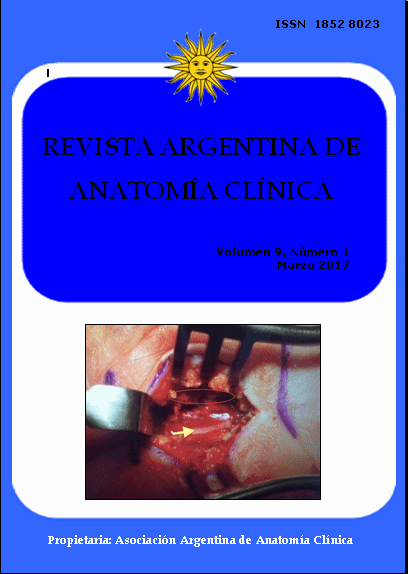MÚSCULO LUMBRICAL COMO CAUSA DE SÍNDROME DEL TÚNEL CARPIANO. Lumbrical muscle within the carpal tunnel as a cause of carpal tunnel syndrome.
DOI:
https://doi.org/10.31051/1852.8023.v9.n1.16475Keywords:
Sindrome del túnel carpiano, músculo lumbrical.carpal tunnel syndrome, lumbricalis muscle, median nerve entrapment.Abstract
El síndrome del túnel carpiano es la neuropatía por atrapamiento mas frecuente. La causa mas frecuente es el disbalance entre contenido y continente del canal carpiano. En este sentido, la presencia de músculos anormales o supernumerarios es una causa poco común pero conocida, de compresión del nervio mediano en el canal carpiano. Se presenta un caso de músculo lumbrical intracanal como posible causa de un síndrome del túnel carpiano.
Carpal tunnel syndrome is the most common entrapment neuropathy. The most frequent cause is the disbalance between content and continent of the carpal tunnel. In this sense, the presence of abnormal or supernumerary muscles is an uncommon but known cause of compression of the median nerve in the carpal canal. A case of intracanal lumbrical muscle is presented as a possible cause of a carpal tunnel syndrome.
Downloads
References
Afshar A, Nasiri B, Mousavi SA, Hesarikia H, Navaeifar N, Taleb H. 2016. Anatomic anomalies encountered in 467 open carpal tunnel surgeries. Arch Iran Med 19:285-287.
Amores M. 2012. Aspectos electrodiagnósticos en el sindrome del túnel carpiano. En: Socolovsky M, Negri P, Gardella J (Eds). Cirugía del túnel carpiano. Controversias y aplicaciones prácticas. Journal, Buenos Aires. 57-64.
Binaghi D. 2013. Estudios por imágenes, cuando son de utilidad?. En: Socolovsky M, Siqueira M, Malessy M (eds.). Introducción a la cirugía de los nervios periféricos. Journal, Buenos Aires. 71-88.
Binaghi D. 2012. Imágenes en el túnel: utilidad de la resonancia magnética, la tomografía computarizada y la ecografía. En: Socolovsky M, Negri P, Gardella J (Eds). Cirugía del túnel carpiano. Controversias y aplicaciones prácticas. Journal, Buenos Aires. 27-40.
Bonilla G, Bianchi H. 2012. Conceptos anatómicos aplicados a la cirugía. En: Socolovsky M, Negri P, Gardella J (Eds). Cirugía del túnel carpiano. Controversias y aplicaciones prácticas. Journal, Buenos Aires.1–18.
Boursinos LA, Dimitriou CG. 2007. Ulnar nerve compression in the cubital tunnel by an epineural ganglion: a case report. Hand (NY) 2:12-5.
Cartwright MS, Walker FO, Newman JC, Arcury TA, Mora DC, Haiying C, Quandt SAP. 2014. Muscle intrusion as a potential cause of carpal tunnel syndrome. Muscle Nerve 50:517-522.
Chhabra A, Subhawong TK, Andreisek G. 2014. Resonancia magnética neurográfica de túneles. Parte 1: nervios de las extremidades superiores. En: Chhabra A, Andreisek G. Resonancia magnética neurográfica. Amolca, Caracas. 37-72.
Chammas M, Boretto J, Burmann LM, Ramos RM, Dos Santos Neto FC, Silva JB. 2014. Carpal tunnel syndrome - Part I (anatomy, physiology, etiology and diagnosis). Rev Bras Ortop 49:429-436.
Christos L, Konstantinos N, Evagelos P. 2015. Revision of carpal tunnel release due to Palmaris Longus Profundus. Case Rep Orthop :616051.
Cobb TK, An KN, Cooney WP. 1995. Effect of lumbrical muscle incursion within the carpal tunnel on carpal tunnel pressure: A cadaveric study. J Hand Surg (Am) 20:186–192.
Martínez F, Medici C, Algorta M. 2012. Síndrome del tunel cubital secundario a músculo anconeoepitroclear: reporte de caso. Rev Arg Anat Onl 3:43-45.
Martinez F, Salle F, Castelluccio G, Moragues R, Pinazzo S, Suarez E. 2013. Variante anatómica de los músculos escalenos y sus implicancias en la cirugía del plexo braquial. Rev Arg Neuroc 27:76-78.
Nayak SR, Rathan R, Chauhan R, Krishnamurthy A, Prabhu LV. 2008. An additional muscle belly of the first lumbrical muscle. Cases J 18;1:103.
Parminder K. 2013. Morphological study of lumbricals. A cadaveric study. J Clin Diagn Res 7:1558-1560.
Pretto Flores L. 2009. Compressao do nervo mediano no punho (Sindorme do túnel do carpo). En: Siqueira MG, Martins RS (eds): Sindromes compressivas de nervos perifericos. Diagnostico e tratamento. DiLivros, Rio de Janeiro:29-48.
Roos DB, Annest SJ, Brantigan CO. 1999. Historical and anatomic perspectives on thoracic outlet syndrome. Chest Surg Clin NA 9:713-723.
Russell SM. 2006. Examination of peripheral nerve injuries. An anatomical approach. Thieme, New York. 107p.
Sbai MA, Benzarti S, Msek H, Boussen M, Khorbi A. 2015. Carpal tunnel syndrome caused by lipoma: a case report. Afr Med J 18:51.
Shimizu A, Ikeda M, Kobayashi Y, Saito I, Mochida J. 2015. Carpal tunnel syndrome with wrist trigger caused by hypertrophied lumbrical muscle and tenosynovitis. Case Rep Orthop 705237.
Singh SK, Midha R. 2008. Carpal tunnel syndrome. In: Midha R, Zager EL (Eds.): Surgery of peripheral nerves. A case based approach. Thieme, New York. 94-99.
Testut L. 1921. Traité D´Anatomie Humaine. 7eme ed, Tome premier. Octave Doin, Paris. 943-945.
Trivedi S, Satapathy BC, Rathore M, Sinha MB. 2016. A rare case of anomalous origin of first lumbrical from the tendon of flexor digitorum superficialis to index finger. J Clin Diagn Res 10:AD03-AD04.
Watchmaker G. 2002. Ulnar nerve compression. In: Allieu Y, Mackinnon SE (Eds.). Nerve compression syndromes of the upper limb. Martin Dunitz. London. 97-116.
Downloads
Published
How to Cite
Issue
Section
License
Authors retain copyright and grant the journal right of first publication with the work simultaneously licensed under a Creative Commons Attribution License that allows others to share the work with an acknowledgement of the work's authorship and initial publication in this journal. Use restricted to non commercial purposes.
Once the manuscript has been accepted for publications, authors will sign a Copyright Transfer Agreement to let the “Asociación Argentina de Anatomía Clínica” (Argentine Association of Clinical Anatomy) to edit, publish and disseminate the contribution.



